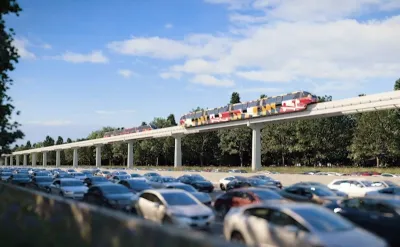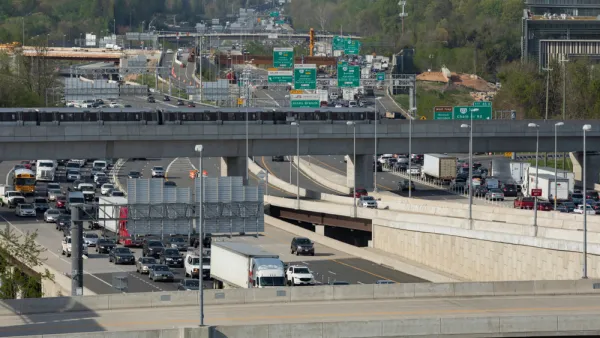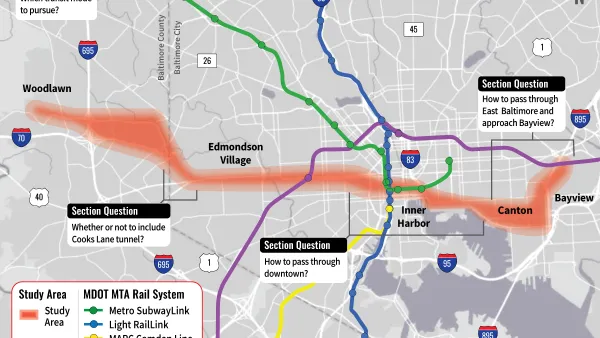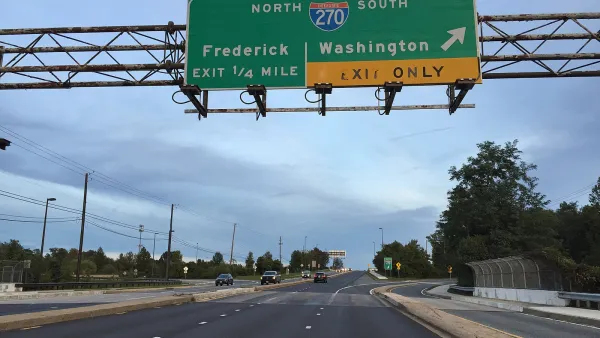The MDOT study found that the monorail line would draw many of its riders from existing public transit systems.

A recent study by the Maryland Department of Transportation (MDOT) found that a proposed monorail line would be a "viable" but not optimal option for reducing traffic on the Interstate 270 corridor. "The corridor," reports Katherine Shaver in the Washington Post, "is Montgomery’s hub for biotech companies, and the highway carries commuters between more affordable homes in farther-out suburbs and jobs in Montgomery, Washington and Northern Virginia."
The $4.4-billion monorail project would cut the 28-mile trip between Frederick and the Shady Grove Metro station to 42-46 minutes, but the study projects that one fifth to one third of riders would come from other transit systems rather than from private vehicles. "More development would have to be clustered around potential station sites to generate ridership, and motorists would need a 'behavioral shift' to switch to mass transit, the study said."
Proponents of the monorail argue that the study's ridership estimates are too conservative and that, if funded, the project would nevertheless be a positive step toward more efficient public transit in the region. "MDOT spokeswoman Erin Henson said the agency will seek feedback on the feasibility study from Montgomery and Frederick counties and see whether either includes a monorail in its annual letter, expected this spring, outlining local transportation funding priorities."
FULL STORY: Monorail is a ‘viable’ transit option for I-270 but wouldn’t reduce traffic, study says

National Parks Layoffs Will Cause Communities to Lose Billions
Thousands of essential park workers were laid off this week, just before the busy spring break season.

Retro-silient?: America’s First “Eco-burb,” The Woodlands Turns 50
A master-planned community north of Houston offers lessons on green infrastructure and resilient design, but falls short of its founder’s lofty affordability and walkability goals.

Delivering for America Plan Will Downgrade Mail Service in at Least 49.5 Percent of Zip Codes
Republican and Democrat lawmakers criticize the plan for its disproportionate negative impact on rural communities.

Test News Post 1
This is a summary

Test News Headline 46
Test for the image on the front page.

Balancing Bombs and Butterflies: How the National Guard Protects a Rare Species
The National Guard at Fort Indiantown Gap uses GIS technology and land management strategies to balance military training with conservation efforts, ensuring the survival of the rare eastern regal fritillary butterfly.
Urban Design for Planners 1: Software Tools
This six-course series explores essential urban design concepts using open source software and equips planners with the tools they need to participate fully in the urban design process.
Planning for Universal Design
Learn the tools for implementing Universal Design in planning regulations.
EMC Planning Group, Inc.
Planetizen
Planetizen
Mpact (formerly Rail~Volution)
Great Falls Development Authority, Inc.
HUDs Office of Policy Development and Research
NYU Wagner Graduate School of Public Service





























